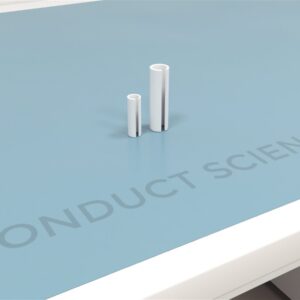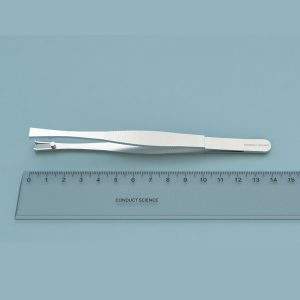Following the acclimation period, introduce the social cue in one of the viewing chambers chosen randomly and observe the subject’s behaviors for 15 minutes.
$1,990.00
Elena Dreosti et al. (2015) employed the Zebrafish Social Interaction 3-Dimensional Evaluation to examine the progression of social behaviors in juvenile zebrafish.
The research was conducted utilizing a specialized behavioral apparatus constructed from a combination of structural framing and optomechanical components. Zebrafish were observed within a tailor-made behavioral enclosure crafted from laser-cut opaque white acrylic, meticulously sealed with silicone, and equipped with both transparent and opaque partitions.
Mazeengineers presents the Zebrafish Social Interaction 3-Dimensional Evaluation.

MazeEngineers empowers preclinical neuroscience research with meticulously designed, customizable behavioral apparatuses. From manual classic mazes to fully automated smart systems, we provide the tools scientists need to capture high-quality, reproducible data for studies on learning, memory, anxiety, and depression.



bool(false)
Features |
5-mm white acrylic walls and 5.5-mm transparent acrylic floor |
U-Shaped arena |
Length of single behavioral arena arm: 4 cm |
Width of single behavioral arena arm: 3.2 cm |
The viewing chamber: 2.1 × 1.3 × 1 cm (L × W × H) |
Width of passage between two arms of the arena: 6 mm |
Arm dividers: transparent divider followed by an opaque divider |
Height of water level: 5 mm |

The latent learning apparatus is utilized to study learning and memory functions in zebrafish by analyzing their spatial exploration behavior. This setup allows fish to explore the maze based on their natural curiosity, without any reinforcement through rewards or punishments. It offers a versatile environment for a wide range of investigations, from understanding basic learning mechanisms to exploring the causes and treatments of learning deficits.
Jensen (2006) describes latent learning as a process where subjects learn the spatial layout of a complex maze simply by wandering through it without any reinforcer. When a reinforcer is later introduced, trained individuals use their acquired spatial knowledge to find the reinforcer more quickly than those who did not undergo unreinforced exploration.
The latent learning apparatus is also useful for assessing disruptions in learning abilities of zebrafish following acute and chronic drug exposure. Additionally, it can be used to study the impact of neurotransmitters on learning acquisition. This tool is invaluable for evaluating the biological and neurological mechanisms, as well as the molecular and cellular structures involved in learning. It is also employed in genetic studies of learning and memory traits in zebrafish.
The apparatus consists of a start box and a goal box connected by tunnels, with the goal box containing stimuli to attract the fish. The movement of fish between the start and goal boxes is regulated by modifiable guillotine doors, and the maze walls are made of acrylic to ensure clear visual access to the goal box from any location within the maze. Other apparatuses used for learning studies in zebrafish include the Zebrafish Associative Learning and Zebrafish Bifurcating T Maze setups.
The Zebrafish Tri-Chamber Social Preference Test features a U-shaped chamber measuring 4 × 3.2 cm, meticulously crafted from 5 mm thick opaque white acrylic, complemented by a transparent 5.5 mm thick floor. Each arm spans 4 cm in length and 3.2 cm in width, optionally partitioned by both transparent and opaque dividers. At the termination of each arm, glass panels fashion compact 1.5 cm² viewing chambers. A narrow passage, 6 mm in width, seamlessly links the two viewing chambers. For optimal testing conditions, the apparatus can be housed within a light-tight enclosure.
Prior to and following trials, thoroughly sanitize the apparatus to mitigate the impact of any residual stimuli on performance. Guarantee adequate illumination within the apparatus and conduct tasks in an environment free from disturbances to diminish the effects of external stimuli on performance. Uphold consistent water quality and parameters throughout trials to mitigate response variability.
For automated tracking and performance recording, consider employing an external tracking and video system like the Noldus EthoVision XT.
Protocols may be tailored to suit the specific investigative requirements of the experiment.
Position the subject within the passageway devoid of any stimuli within the viewing chamber. Allocate a 15-minute period for the subject to acclimate to the apparatus. Utilize this phase to observe and document baseline behaviors.
Following the acclimation period, introduce the social cue in one of the viewing chambers chosen randomly and observe the subject’s behaviors for 15 minutes.
Dreosti, Lopes, Kampff, and Wilson (2015) explored the impact of pharmacological interventions on the social behaviors of 3-week-old AB strain zebrafish using the Zebrafish 3-Chamber Social Preference Assay. Subjects were segregated into two experimental groups: one receiving MK-801 and the other ethanol treatments. Age-matched social cues were employed during the experiments.
The MK-801 group received an acute dosage of 100 µM of MK-801 dissolved in the fish water, administered one hour before testing. Compared to untreated subjects, those treated with MK-801 exhibited reduced pre- and post-bout quiescent periods, leading to a decrease in bout generation periodicity. Moreover, treated fish displayed no social preference and were less influenced by the movements of the social cue fish, unlike untreated counterparts.
The ethanol-treated group was subdivided into low (0.125%) and high (0.5%) dosage cohorts, mirroring the MK-801 treatment protocol. While the low-dose group maintained a robust Social Preference Index, the high-dose group demonstrated a significant decline in social preferences and distribution of the Social Preference index. Other social parameters were minimally impacted or remained unaffected.
In a study by Felter-Rodriguez (2017), the necessity of the transcription factor interferon regulatory factor-8 (IRF8) in the development of social preferences in zebrafish was examined. The investigation utilized the Zebrafish 3-Chamber Social Preference Assay, incorporating a 10-minute acclimation period followed by an additional 5 minutes with the social cue.
At 7 days post-fertilization, IRF8 mutant zebrafish displayed no discernible social preference, whereas at 19 days post-fertilization, the mutants exhibited a preference for viewing the cue from a distance. However, starting at 21 days post-fertilization, comparison of social behaviors between the mutants and wild-type counterparts revealed no significant disparities. Both groups demonstrated a notable increase in social preference when in the presence of the cue fish. Consequently, the study concluded that microglia do not play a role in shaping social preferences in this particular animal model.
Fernandes, Rampersad, Jones, and Eberhart (2019) conducted a study to assess the social preferences of AB strain zebrafish at ages 3 and 16 weeks subsequent to embryonic exposure to ethanol. Ethanol exposure during embryonic development was administered at concentrations of either 1% or 5% (equating to approximately 41- and 62-mM tissue levels of ethanol) by treating chlorinated embryos in embryo medium from 24 to 26 hours post-fertilization.
Zebrafish larvae, aged 3 weeks, were subjected to the Zebrafish 3-Chamber Social Preference Assay, where two age-matched conspecifics were placed in one of the viewing chambers, visually obscured by a removable opaque panel. Following the habituation period, behaviors were observed for 15 minutes. While the 1% ethanol-treated group displayed slightly reduced locomotion and the 1.5% group exhibited slightly increased activity compared to controls, no statistically significant differences were observed between the control and alcohol-treated groups. Furthermore, all groups demonstrated similar zone preferences during the habituation phase, with a preference for the zone nearest to the social cues when visible.
At 16 weeks of age, the same fish underwent testing in a three-tank setup, utilizing two males and two females shoals in one of the adjacent tanks, following a protocol similar to the larval assay. The adult assay revealed a significant interaction between alcohol treatment and zone preference. Compared to controls spending 69% of their time near the shoal, the 1% and 1.5% ethanol-treated groups only spent 32% and 39% of their time in that zone, respectively. This led to the conclusion that while larval social preferences remain largely unaffected, embryonic ethanol exposure influences the shoaling responses of adults irrespective of dosage.
The virtual division of the arm leading to the viewing chamber is recommended to aid with the observations.
The following behaviors and parameters in the Zebrafish 3-Chamber Social Preference Assay:
The Zebrafish 3-Chamber Social Preference Assay facilitates the straightforward assessment of social preferences in zebrafish across both illuminated and dim conditions. Featuring a U-shaped design, the apparatus incorporates two viewing chambers constructed with glass panels. As subjects do not directly interact with social cues, these cues can be introduced or removed during trials to monitor behavioral alterations. Moreover, the versatility of the apparatus extends beyond social preference assessments, allowing for the observation of additional social behaviors such as predator-prey interactions and social isolation. Furthermore, simple adaptations can be implemented to tailor the apparatus for other assays reliant on visual cues.
Managing stress during the assay can serve as a significant stressor itself. Inadequate lighting and the persistence of residual stimuli or cues have the potential to impact behaviors. Fluctuations in environmental factors like temperature, pH levels, or water quality may also influence observed responses. Moreover, performances can exhibit variations across species and may be influenced by individual disparities, including age and gender.
There are no questions yet. Be the first to ask a question about this product.